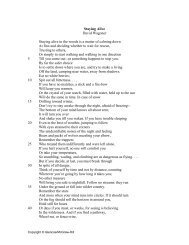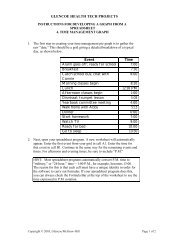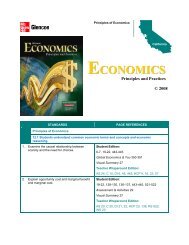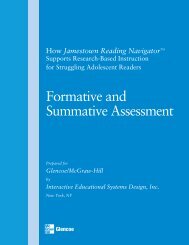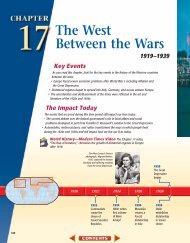Math Handbook - Glencoe
Math Handbook - Glencoe
Math Handbook - Glencoe
Create successful ePaper yourself
Turn your PDF publications into a flip-book with our unique Google optimized e-Paper software.
APPENDIX B<br />
<strong>Math</strong> <strong>Handbook</strong><br />
Table 2<br />
Gas Pressures in Air<br />
Pressure<br />
(kPa)<br />
Nitrogen gas 79.10<br />
Carbon dioxide gas 0.040<br />
Trace gases 0.94<br />
Total gases 101.3<br />
remember that the result never can be more precise than the least precise measurement.<br />
That is, your answer cannot have more significant figures than the<br />
least precise measurement. Be sure to perform all calculations before dropping<br />
any insignificant digits.<br />
The following rules determine how to use significant figures in calculations<br />
that involve measurements.<br />
1. To add or subtract measurements, first perform the mathematical operation,<br />
then round off the result to the least precise value. There should be<br />
the same number of digits to the right of the decimal as the measurement<br />
with the least number of decimal digits.<br />
2. To multiply or divide measurements, first perform the calculation, then<br />
round the answer to the same number of significant figures as the measurement<br />
with the least number of significant figures. The answer should<br />
contain no more significant figures than the fewest number of significant<br />
figures in any of the measurements in the calculation<br />
EXAMPLE PROBLEM 2<br />
<strong>Math</strong> <strong>Handbook</strong><br />
Air contains oxygen (O 2 ), nitrogen (N 2 ), carbon dioxide (CO 2 ), and trace<br />
amounts of other gases. Use the known pressures in Table 2 to calculate<br />
the partial pressure of oxygen.<br />
To add or subtract measurements, first perform the operation, then<br />
round off the result to correspond to the least precise value involved.<br />
P O2 P total (P N2 P CO2 P trace )<br />
P O2 101.3 kPa (79.11 kPa 0.040 kPa 0.94 kPa)<br />
P O2 101.3 kPa 80.090 kPa<br />
P O2 21.210 kPa<br />
The total pressure (P total ) was measured to the tenths place. It is the least<br />
precise measurement. Therefore, the result should be rounded to the<br />
nearest tenth of a kilopascal. The leftmost dropped digit (1) is less than<br />
five, so the last two digits can be dropped.<br />
The pressure of oxygen is P O2 21.2 kPa.<br />
A small, hand-held pressure<br />
gauge can be used to monitor<br />
tire pressure.<br />
EXAMPLE PROBLEM 3<br />
The reading on a tire-pressure gauge is 35 psi. What is the equivalent<br />
pressure in kilopascals?<br />
P 35 psi 1 01.<br />
3 kPa<br />
<br />
14.<br />
7 psi<br />
P 241.1904762 kPa<br />
There are two significant figures in the measurement, 35 psi. Thus, the<br />
answer can have only two significant figures. Do not round up the last<br />
digit to be kept because the leftmost dropped digit (1) is less than five.<br />
The equivalent pressure is P 240 kPa 2.4 10 2 kPa.<br />
896 Chemistry: Matter and Change




